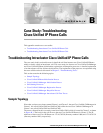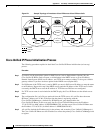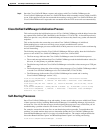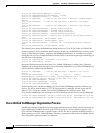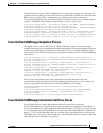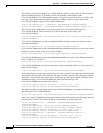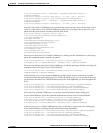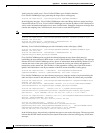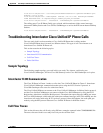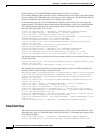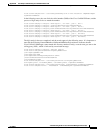
B-7
Troubleshooting Guide for Cisco Unified CallManager Release 5.0(2)
OL-9420-01
Appendix B Case Study: Troubleshooting Cisco Unified IP Phone Calls
Troubleshooting Intracluster Cisco Unified IP Phone Calls
16:05:43.406 CCM|StationInit - InboundStim - KeypadButtonMessageID kpButton: 0
tcpHandle=0x4fbbc30
16:05:43.406 CCM|Digit analysis: match(fqcn="", cn="1001", pss="", dd="100")
16:05:43.406 CCM|Digit analysis: potentialMatches=PotentialMatchesExist
16:05:43.562 CCM|StationInit - InboundStim - KeypadButtonMessageID kpButton: 0
tcpHandle=0x4fbbc30
16:05:43.562 CCM|Digit analysis: match(fqcn="", cn="1001", pss="", dd="1000")
After the Cisco Unified CallManager has received enough digits to match, it provides the digit analysis
results in a table format. Cisco Unified CallManager ignores any extra digits that are pressed on the
phone after this point because a match has already been found.
16:05:43.562 CCM|Digit analysis: analysis results
16:05:43.562 CCM||PretransformCallingPartyNumber=1001
|CallingPartyNumber=1001
|DialingPattern=1000
|DialingRoutePatternRegularExpression=(1000)
|PotentialMatches=PotentialMatchesExist
|DialingSdlProcessId=(1,38,2)
|PretransformDigitString=1000
|PretransformPositionalMatchList=1000
|CollectedDigits=1000
|PositionalMatchList=1000
|RouteBlockFlag=RouteThisPattern
The next trace shows that Cisco Unified CallManager is sending out this information to a called party
phone (the tcpHandle number identifies the phone).
16:05:43.578 CCM|StationD - stationOutputCallInfo CallingPartyName=1001,
CallingParty=1001, CalledPartyName=1000, CalledParty=1000, tcpHandle=0x4fbb150
The next trace indicates that Cisco Unified CallManager is ordering the lamp to blink for incoming call
indication on the called party Cisco Unified IP Phone.
16:05:43.578 CCM|StationD - stationOutputSetLamp stim: 9=Line instance=1
lampMode=LampBlink tcpHandle=0x4fbb150
In the following traces, Cisco Unified CallManager provides ringer, display notification, and other
call-related information to the called party Cisco Unified IP Phone. Again, you can see that all messages
get directed to the same Cisco Unified IP Phone because the same tcpHandle gets used throughout the
traces.
16:05:43.578 CCM|StationD - stationOutputSetRinger: 2=InsideRing tcpHandle=0x4fbb150
16:05:43.578 CCM|StationD - stationOutputDisplayNotify tcpHandle=0x4fbb150
16:05:43.578 CCM|StationD - stationOutputDisplayPromptStatus tcpHandle=0x4fbb150
16:05:43.578 CCM|StationD - stationOutputSelectSoftKeys tcpHandle=0x4fbb150
Notice that Cisco Unified CallManager also provides similar information to the calling party
Cisco Unified IP Phone. Again, the tcpHandle differentiates between Cisco Unified IP Phones.
16:05:43.578 CCM|StationD - stationOutputCallInfo CallingPartyName=1001,
CallingParty=1001, CalledPartyName=, CalledParty=1000, tcpHandle=0x4fbbc30
16:05:43.578 CCM|StationD - stationOutputCallInfo CallingPartyName=1001,
CallingParty=1001, CalledPartyName=1000, CalledParty=1000, tcpHandle=0x4fbbc30
In the next trace, Cisco Unified CallManager provides an alerting or ringing tone to the calling party
Cisco Unified IP Phone, notifying that the connection has been established.
16:05:43.578 CCM|StationD - stationOutputStartTone: 36=AlertingTone tcpHandle=0x4fbbc30
16:05:43.578 CCM|StationD - stationOutputCallState tcpHandle=0x4fbbc30
16:05:43.578 CCM|StationD - stationOutputSelectSoftKeys tcpHandle=0x4fbbc30
16:05:43.578 CCM|StationD - stationOutputDisplayPromptStatus tcpHandle=0x4fbbc30



